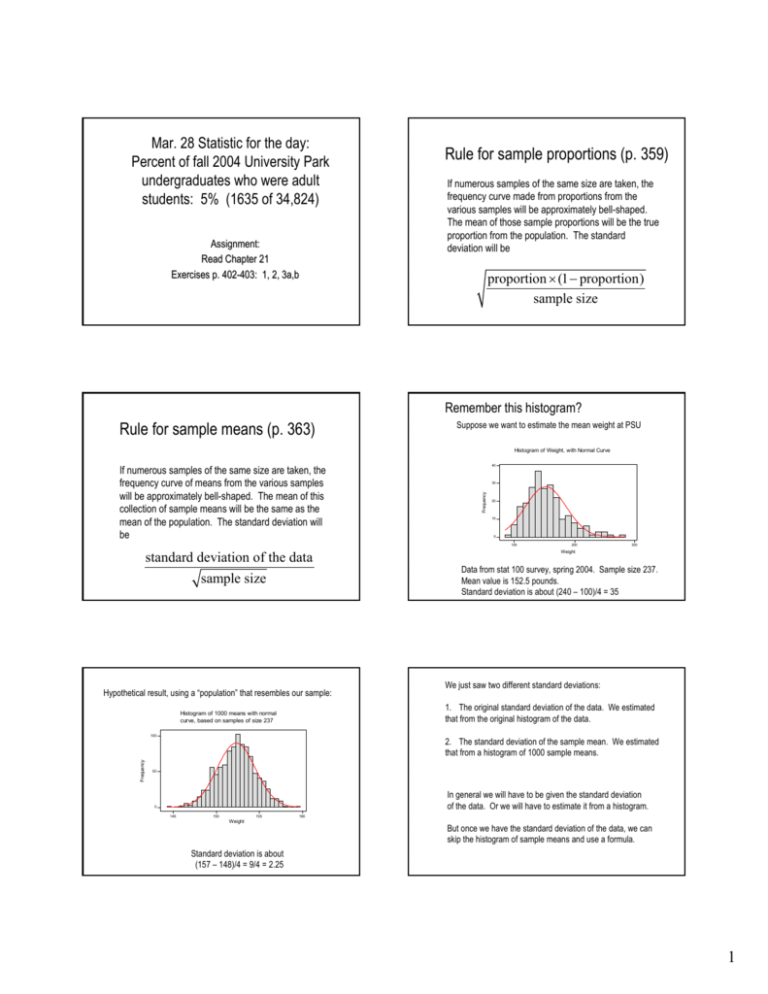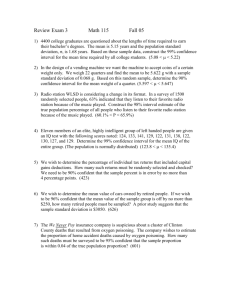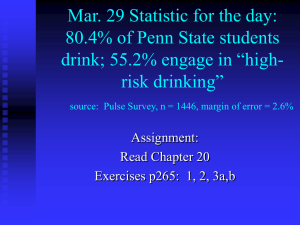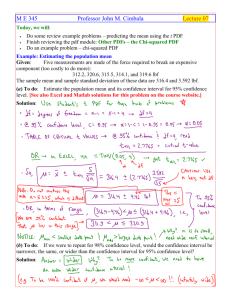Rule for sample proportions (p. 359) Rule for sample means (p. 363)
advertisement

Mar. 28 Statistic for the day: Percent of fall 2004 University Park undergraduates who were adult students: 5% (1635 of 34,824) Assignment: Read Chapter 21 Exercises p. 402402-403: 1, 2, 3a,b Rule for sample proportions (p. 359) If numerous samples of the same size are taken, the frequency curve made from proportions from the various samples will be approximately bell-shaped. The mean of those sample proportions will be the true proportion from the population. The standard deviation will be proportion × (1 − proportion) sample size Remember this histogram? Rule for sample means (p. 363) Suppose we want to estimate the mean weight at PSU Histogram of Weight, with Normal Curve 30 Frequency If numerous samples of the same size are taken, the frequency curve of means from the various samples will be approximately bell-shaped. The mean of this collection of sample means will be the same as the mean of the population. The standard deviation will be 40 20 10 0 100 standard deviation of the data sample size Hypothetical result, using a “population” that resembles our sample: 300 Data from stat 100 survey, spring 2004. Sample size 237. Mean value is 152.5 pounds. Standard deviation is about (240 – 100)/4 = 35 We just saw two different standard deviations: 1. The original standard deviation of the data. We estimated that from the original histogram of the data. Histogram of 1000 means with normal curve, based on samples of size 237 100 Frequency 200 Weight 2. The standard deviation of the sample mean. We estimated that from a histogram of 1000 sample means. 50 In general we will have to be given the standard deviation of the data. Or we will have to estimate it from a histogram. 0 145 150 155 Weight 160 But once we have the standard deviation of the data, we can skip the histogram of sample means and use a formula. Standard deviation is about (157 – 148)/4 = 9/4 = 2.25 1 So in our example of weights: Formula for estimating the standard deviation of the sample mean (don’t need histogram) Suppose we have the standard deviation of the original sample. Then the standard deviation of the sample mean is: Sample size is 237 Hence by our formula: SEM = SD/square root of sample size standard deviation of the data sample size Standard error of the mean is 35 divided by the square root of 237: SEM = 35/15.4 = 2.3 Jargon: The standard deviation of the mean is also called the standard error or the standard error of the mean and abbreviated SEM or SE Mean. Using the margin of error of 2 SEMs we really have a 95% confidence interval for the pop mean. Normal Curve of sample mean. The standard error is 2.3 and the bell is centered at 152.5. 8 The standard deviation of the sample is about 35. Write SD = 35. So the margin of error of the sample mean is 2×2.3 = 4.6 Report 152.5 ± 4.6 or 147.9 to 157.1 Steps for a 95% confidence interval for a population mean: 1. sample mean: 152.5 (given) 2. sample standard deviation: SD = 35 (given) 3. sample size: 237 (given) Anatomy of a 95% conf idence interv al 7 6 4. standard error of the mean: SEM = 35/sqrt(237) = 2.3 (you calculate) 5 4 3 5. number of SEMs for 95% confidence: 2 (use p. 157 if needed) 95% in middle 2 1 2 SEM 0 147.9 152.5 sample mean 157.1 True pop mean in here someplace Example: Estimate mean # of pairs of jeans owned by a student at PSU Now put it all together: 6. 95% confidence interval for pop mean: 152.5 ± 2×(2.3) 152.5 ± 4.6 or 147.9 to 157.1 Example: Estimate mean # of pairs of jeans owned by a student at PSU 50 40 St. Dev. = 5.8 pairs 30 Sample size = 222 20 Mean = 7.8 pairs SEM = 5.8 = 0.4 222 # of SEMs for 98% confidence: 2.33 Mean = 7.8 pairs St. Dev. = 5.8 pairs Sample size = 222 10 98% confidence interval: 0 Frequency Histogram of Jeans 0 10 20 30 40 Give a 98% confidence interval. 7.8 ± 2.33×0.4 7.8 ± 0.9, or 6.9 to 8.7 Give a 98% confidence interval. Jeans 2 Fibonacci Sequence Interpretation: We estimate that the population of Penn State students owns 7.8 pairs of jeans on average. 98% confidence interval is 6.9 to 8.7 pairs, a reasonable range of values for the true (population) mean. Guess the next numbers in the sequence 1, 1, 2, 3, 5, 8, 13, 21, 34, ... Called a Fibonacci sequence. Ratios of pairs after a while equal approximately .618 eg. 8/13 = .615 13/21 = .619 21/34 = .618 width Daisy Head length If 21 clockwise spirals 34 counterclockwise width = .618 length then the rectangle is called a golden rectangle. Parthenon in Athens Villa in Paris by Le Corbusier 3 La Parade Georges Seurat St. Jerome Leonardo da Vinci Place de la Concorde Piet Mondrian Width to Length ratios for rectangles appearing on beaded baskets of the Shoshoni The golden rectangle has become an aesthetic standard for western civilization. Width to Length ratio of rectangles in Shoshoni beaded baskets 0.85 0.75 C1 It appears in many places: architecture art pyramids business cards credit cards 0.693 0.662 0.690 0.606 0.570 0.749 0.652 0.628 0.609 0.844 0.654 0.615 0.668 0.601 0.576 0.670 0.606 0.611 0.553 0.633 0.625 0.610 0.600 0.633 0.595 Research question: Do non-western cultures also incorporate the golden rectangle as an aesthetic standard? 0.65 Golden Rectangle: .618 0.55 Question: Is the golden rectangle (.618) a reasonable value for the mean of the population of Shoshoni rectangles? 1. 2. 3. 4. sample mean: .638 sample standard deviation: SD = .061 sample size: 25 standard error of the mean: SEM = .012 (I calculated it for you.) How would you create a 95% confidence interval for the population mean? (We’d like to know whether .618 is in this interval.) True or False? To construct a confidence interval for a population PROPORTION, it is enough to know the sample proportion and the sample size. To construct a confidence interval for a population MEAN, it is enough to know the sample mean and the sample size. 4 Does each of the following tend to make a confidence interval WIDER or NARROWER? A larger sample size A larger confidence coefficient A larger standard error of the mean A sample proportion closer to .5 A larger sample mean 5










